The Scuola dei Varoteri is a building located facing the Campo Santa Margherita in the sestiere of Dorsoduro, Venice, Italy.

The Scuola dei Varoteri is a building located facing the Campo Santa Margherita in the sestiere of Dorsoduro, Venice, Italy.

The two story brick building is unusual for standing detached in the large square. It served as the home of the confraternity of the tanners and furriers, founded in 1311, and who had moved from Cannaregio to this location in 1725. It was thus the home of one of the nearly 400 scuola minori or piccole that once existed in the city. In the 19th and 20th century it served as a store for firewood, movie theater, and fascist education hall. [1] [2]
On the second floor is a marble relief of the Madonna della Misericordia (1501), which was once attached to the guild's church. Coordinates: 45°26′02″N12°19′25″E / 45.433984°N 12.323558°E
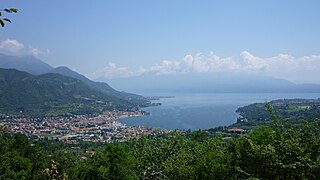
Salò is a town and comune in the Province of Brescia in the region of Lombardy on the banks of Lake Garda, on which it has the longest promenade. The city was the seat of government of the Italian Social Republic from 1943 to 1945, with the ISR often being referred to as the "Salò Republic".
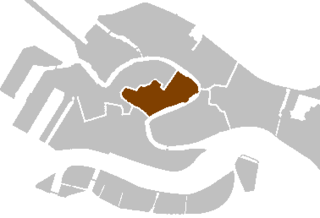
San Polo is the smallest and most central of the six sestieri of Venice, northern Italy, covering 86 acres (35 hectares) along the Grand Canal. It is one of the oldest parts of the city, having been settled before the ninth century, when it and San Marco formed part of the Realtine Islands. The sestiere is named for the Church of San Polo.

Dorsoduro is one of the six sestieri of Venice, in northern Italy.

The Venetian Ghetto was the area of Venice in which Jews were compelled to live by the government of the Venetian Republic. The English word ghetto is derived from the Jewish ghetto in Venice. The Venetian Ghetto was instituted on 29 March 1516. It was not the first time that Jews in Venice were compelled to live in a segregated area of the city. In 1552 Venice had 160,000 inhabitants, including 900 Jews, who were mainly merchants.

The Gallerie dell'Accademia is a museum gallery of pre-19th-century art in Venice, northern Italy. It is housed in the Scuola della Carità on the south bank of the Grand Canal, within the sestiere of Dorsoduro. It was originally the gallery of the Accademia di Belle Arti di Venezia, the art academy of Venice, from which it became independent in 1879, and for which the Ponte dell'Accademia and the Accademia boat landing station for the vaporetto water bus are named. The two institutions remained in the same building until 2004, when the art school moved to the Ospedale degli Incurabili.
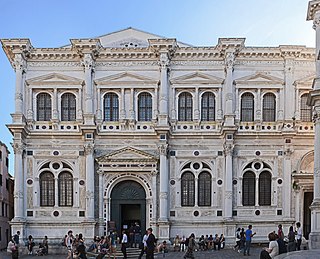
The Scuola Grande di San Rocco is a building in Venice, northern Italy. It is noted for its collection of paintings by Tintoretto and generally agreed to include some of his finest work.

The Museo Correr is a museum in Venice, northern Italy. Located in St. Mark's Square, Venice, it is one of the 11 civic museums run by the Fondazione Musei Civici di Venezia. The museum extends along the southside of the square on the upper floors of the Procuratorie Nuove. With its rich and varied collections, the Museo Correr covers both the art and history of Venice.

The Fondaco dei Turchi is a Veneto-Gothic style palazzo, later on named as the Turks' Inn, on the Grand Canal of Venice, northeast Italy.

The Scuola Grande di San Marco is a building in Venice, Italy, designed by the well-known Venetian architects Pietro Lombardo, Mauro Codussi, and Bartolomeo Bon. It was originally the home to one of the Scuole Grandi of Venice, or six major confraternities, but is now the city's hospital. It faces the Campo San Giovanni e Paolo, one of the largest squares in the city.

Castello is the largest of the six sestieri of Venice, Italy.

The Scuola vecchia della Misericordia is a former charity building in Venice, Italy, in the sestiere of Cannaregio. It is located near the north margin of the city, at the intersections of Rio della Sensa and the confluence of Rio di Noale and Rio di San Falice.
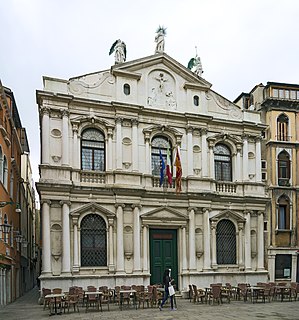
The Ateneo Veneto di Scienze, Lettere ed Arti is an institution for the promulgation of science, literature, art and culture in all forms, in the exclusive interest of promoting social solidarity, located in Venice, northern Italy. The Ateneo Veneto is made up of three-hundred members resident in the city and in the province of Venice, elected by the Assembly, which is also responsible for appointing the Chairman and the Academic Council. Honorary, Non-Resident and Foreign Members, elected by the Assembly also participate in the life of the Ateneo.

The Scuola Grande di San Giovanni Evangelista is a confraternity building located in the San Polo sestiere of the Italian city of Venice. Founded in the 13th century by a group of flagellants it was later to become one of the five Scuole Grandi of Venice. These organisations provided a variety of charitable functions in the city as well as becoming patrons of the arts. The Scuola Grande di San Giovanni Evangelista is notable for housing a relic of the true cross and for the series of paintings it commissioned from a number of famous Venetian artists depicting Miracles of the Holy Cross. No longer in the school, these came into public ownership during the Napoleonic era and are now housed in the Gallerie dell'Accademia. The scuola is open to visitors on a limited number of days, detailed on the official website.

The Francesco Morosini Naval Military School is a military education college based in Venice operated by the Italian Navy and named after the great venetian Doge.

The Scuola di San Giorgio degli Schiavoni in Venice, northern Italy, was one of the city's historical scuole.

The Scuola degli Albanesi is a building in Venice, northern Italy.
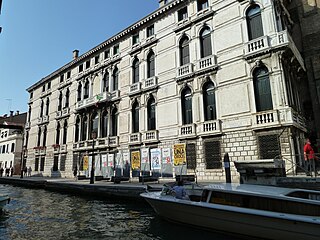
The Palazzo da Lezze or Ca' Lezze is a Baroque palace in Sestiere of Cannaregio in the city of Venice, Italy. It is located on Rio della Misericordia, with a facade on the fondamenta (canal-sidewalk), and stands between the Scuola Grande Nuova della Misericordia and Calle Largo Lezze.

Campo Santa Margherita is a large city square in the sestiere of Dorsoduro of Venice, Italy. It is located near the University in Venice.

The Palazzo Loredan Cini is a Gothic-style palace located between the Palazzo Balbi Valier and the Rio San Vio on the Grand Canal, in the sestiere of Dorsoduro, Venice, Italy. The palace was formed from the amalgamation of the former Palazzo Foscari-Loredan with the adjacent Palazzo Grimani. The narrow facade on the Canal has no entrance, but the facade to the north on the Rio, has a single water door, and is connected to the adjacent campo by a bridge. The facade is decorated with two poliforas.

The Canton Synagogue is one of five synagogues in the Jewish Ghetto of Venice, Italy. Established only four years after the nearby Scuola Grande Tedesca (1528), it is the second oldest Venetian synagogue. Its origins are uncertain: it might have been constructed as a prayer room for a group of Provençal Jews soon after their arrival in Venice, or as a private synagogue for a prominent local family. Repeatedly remodeled throughout its history, its interior is predominantly decorated in the Baroque and Rococo styles.